
Back to Loco of the Month homepage
Back to Sidestreet Bannerworks
.
December 2005
Hugh Saunders' Edward Thomas
by Marc Horovitz

Edward Thomas was built by Kerr-Stuart for the Corris Railway in Wales in 1921. In 1951, the engine went to the 2'3"-gauge Talyllyn Railway, a slate hauler that opened in 1866 and later became Great Britain's first preserved railway. The 0-4-2T entered service there in 1952 after some repairs had been made, and has been there ever since. For a while it was painted red and bore the name Peter Sam, after the Reverend Awdrey's creation in the Thomas the Tank Engine series. Peter Sam was, in fact, modeled on Edward Thomas. Today, Edward Thomas runs under its own name and is painted bronze and black, with yellow lining -- standard Talyllyn colors.
The model
Edward Thomas, the model, was constructed by Hugh Saunders, a private builder in the UK. Mr. Saunders sometimes made engines in small batches. This is one of those. (Other of his engines reviewed in these pages include a coal-fired 2-6-2 and an 0-4-0T.) Like his other models, this one is quite sophisticated and built to a high, workmanlike standard. The detail level is relatively low and all working parts are robust and precisely made.
The locomotive features a Wrighton-style, single flue, alcohol-fired boiler. There are water cross tubes in the large flue and additional water tubes in the top of the firebox to increase the heating area. The burner is unusual. It is basically an open-top box, stuffed with asbestos wicking. There are eight tubes coming up through it that admit air from under the burner to the fire. Because access is so tight, the fire is lit through the firebox door, found in the usual place. There is a hole in the back sheet for access to the firebox. The fuel tank is forward of the burner, between the frames. Fuel is introduced through two hatches, one on either side of the engine, beneath the saddle tank.
For access to the backhead, the top of the cab's back sheet comes off. The boiler has the usual fittings: safety valve, throttle, water glass, pressure gauge, and blower valve. A hand pump resides in on the right side of the cab, next to the boiler. Water is taken from the working saddle tank by a hand pump next to the boiler, but only from one side. There is no balance pipe.
Valve gear is Hackworth, controlled from the cab. Each of the motion parts is beautifully made. The trailing truck just slips in place. It can be removed in a second, but is held in position when the locomotive is on the track.
The run
The engine was prepared as usual, then placed on the track. Because the boiler is internally fired, a suction fan is necessary to draw the fire through it until there is sufficient pressure (15-20 pounds) to turn on the engine's own blower. I turned on the fan, then lit the fire through the firebox door. While pressure was coming up, I wiped down the track.
It was a chilly, overcast day, with the temperature down near the freezing mark. Pressure slowly rose. At around 15 psi, i removed the fan and turned on the blower. Pressure continued to rise slowly. When it got to 40 pounds, I closed the blower and opened the throttle. The engine lurched forward a couple of inches, spitting water out the stack, and stopped, solidly locked up by water in the cylinders. I closed the throttle, reversed the gear, and opened it again, with much the same result. I did this three or four more times, the engine showing a little more sign of life each time, until it finally moved off under its own power.
Edward Thomas is a docile, smooth-running locomotive. The throttle lever has a nice handle on it and it's easily accessible. The reverser is a little awkward, but not too bad. After a couple of laps, the water level was down, so I stopped the engine and pumped up the boiler. Because of the large firebox and fire tube, water space is somewhat limited, so an eye must be kept on the glass. Also, when runnin g light, I found that the fire behaved better with the blower open a bit.
After a few laps, I coupled the engine to a friend's train of four or five plastic LGB cars. The engine walked away with them. Fuel and water were added as necessary, and the run continued for half an hour or so, until I got too cold. Despite the gray weather, the run was good. This locomotive, like all of Hugh Saunders' that I've had the pleasure of running, performed wonderfully and looked great doing it.
.
|
|
|
| Builder | Hugh Saunders |
| Date built | Early 1980s (?) |
| Gauge | 0 (32mm) |
| Scale | 16mm = 1'0" |
| Boiler | Internally fired, single flue with cross tubes, water tubes in firebox |
| Fittings | Safety valve, throttle, blower, water glass, pressure gauge, check valve |
| Fuel | Alcohol |
| Blow-off pressure | 45 psi |
| Cylinders | Two, double-acting D-valve |
| Reversing gear | Hackworth |
| Lubricator | Displacement |
| Weight | 5 lbs. 14 oz. |
| Dimensions | Length over end beams, 9-1/2"; width, 3-1/2"; height, 5-5/8" |
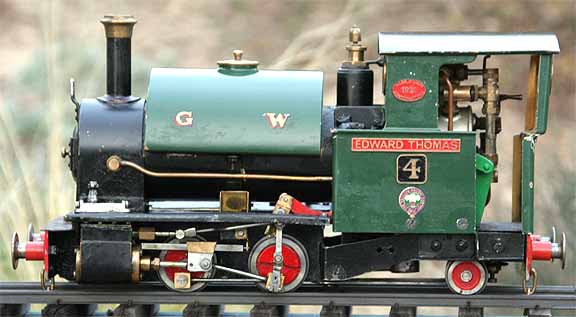
Edward Thomas is a finely crafted model of a popular Welsh locomotive. The lid for an alcohol filler vent can be seen on the footplate under the boiler, between the "G" and the "W". The steam line above it is for the blower.

.

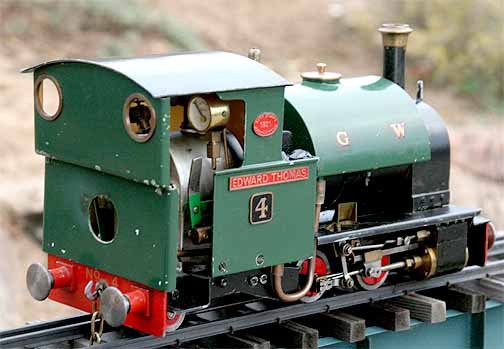
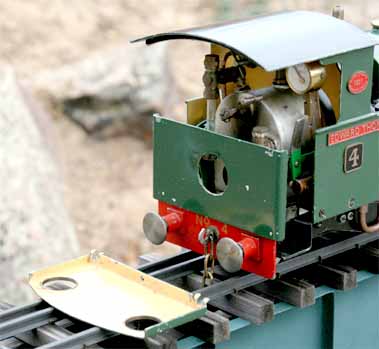
The top section of the back sheet just clips in place. It's easily removed for cab access.
.
The rear of the engine. The hole in the back sheet is for access to the firebox door with a match.
.



Above: The displacement lubricator is that small screw on the footplate. The smokebox door is a dummy.
Above right: The running gear. All parts that are not made of round rod are carved from the solid -- no stamped sheet-metal bits here. Each of the rod ends has a lube hole for oil.
Right. With the cab back off, controls are easily accessible. Atop the boiler is the blower valve. The firebox hole can just be seen through the backsheet hole.
.
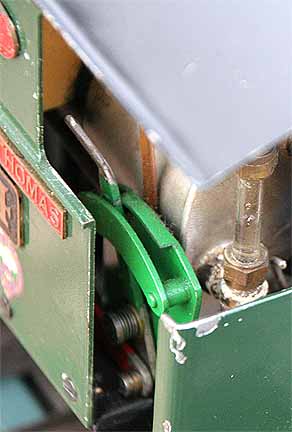

Left: The reversing lever. Above: The hand pump. Below left: The filler cap to the saddle tank. Below: The trailing truck off. A stud under the loco engages the slot and the sprung pin supports the rear of the engine when in place.

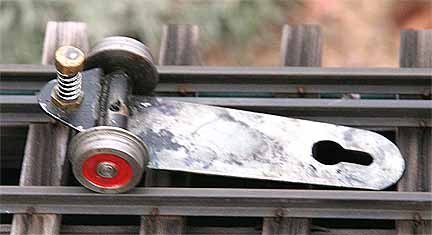


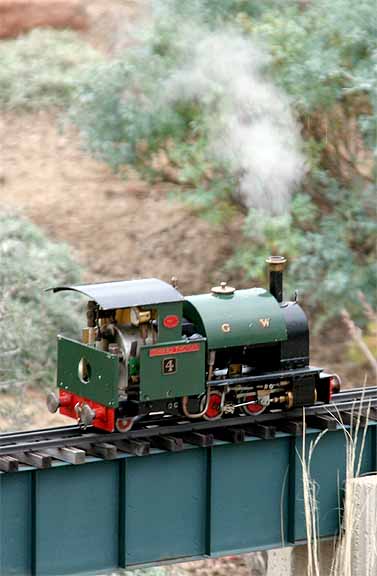
Above: A suction fan is used to raise steam from cold. At around 20 psi, it can be removed and the engine's blower turned on.
Right: Edward Thomas crosses the viaduct at (not very great) speed. The cold, gray day made for some good steam effects.
Back to Loco of the Month home page
Back to Sidestreet Bannerworks home page
This page and its contents
Copyright Sidestreet Bannerworks, 2005
.